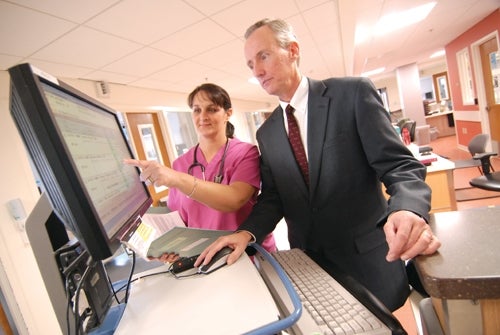Medicine Enters A New Era | Nudged by government incentives, hospitals discover benefits of using technology to improve patient care
 Photo/Edd Cote
Edward Kelly, president of Milford Regional Medical Center, and Terri Winslow, a registered nurse, review information at one of the Milford hospital's “computers on wheels,  which contain patients' medical records. The computers replace the clipboards and binders that have traditionally been used in health care facilities.
Photo/Edd Cote
Edward Kelly, president of Milford Regional Medical Center, and Terri Winslow, a registered nurse, review information at one of the Milford hospital's “computers on wheels,  which contain patients' medical records. The computers replace the clipboards and binders that have traditionally been used in health care facilities.
Slowly but surely, electronic medical records systems are coming together at area hospitals, the result of concerted efforts and big investments over the past five years.
The aims of such systems are many: make hospital operations paperless, avoid costly and dangerous medical errors, improve efficiencies and provide more transparency for patients.
The development of the systems is a big undertaking, involving IT professionals, doctors, nurses and administrative staff. Using the systems represents a significant change for staff, whose attitudes can range from apprehensive to gung-ho.
Some of the promised benefits of EMR systems have yet to be realized, according to interviews with Central Massachusetts hospital executives. One reason is that the technology is still evolving, said Karen Marhefka, associate chief information officer for UMass Medical Center in Worcester. “The benefit of an EMR comes in a lot of other areas, but efficiency is not going to be one of them for a while,” Marhefka said.
Not all doctors would entirely agree with that sentiment. Some insist they have saved time in some areas.
End Goal: Uniformity
But what they all agree on is that the technology is not yet optimal. There are many different records systems and many of them don’t yet talk to each other. Federal- and state-level efforts are aimed at achieving a degree of uniformity in the systems so they can be integrated.
With the help of state and federal funding, the Massachusetts Technology Collaborative is also working to design a network to which smaller providers and specialists who don’t have the capital upfront to invest could connect.
In the meantime, hospitals are just starting to see their work bear fruit in the form of incentive payments from the federal government.
That money, for early adopters and users of EMR technology, is on the way, while some have already received it. Some hospitals are in line to receive millions in incentive payments from the U.S. Department of Health and Human Services for demonstrating “meaningful use” of their systems. More than $20 billion in incentives for health care IT were included in a portion of the American Recovery and Reinvestment Act of 2009, more commonly known as the stimulus bill. Payments will continue next year for hospitals that continue to hit increasing benchmarks.
Staring At 2015 Deadline
The stimulus bill contained carrots, but also a stick. Hospitals that don’t meet meaningful use standards by 2015 will see reductions in their Medicare reimbursement rates. And a state law requires physician order entries to be electronic by this time next year. Providers who don’t meet that benchmark (and some are not there yet) could face problems renewing their licenses.
The UMass health care system has 560 physicians eligible for incentive payments totaling approximately $10 million, Marhefka said. UMass will get the majority of that to help rebate some of its large investments in technology, training and support exceeding $100 million. Doctors will receive some of the money in bonuses, she said.
As for UMass’ hospital campuses, HealthAlliance in Leominster will receive $2.6 million this year.
The system’s other campuses aren’t quite as far along. Worcester Memorial, Clinton Hospital and Marlborough Hospital will go live with an outpatient EMR system in December. Those hospitals will be up and running on the system by December and will apply for their money in 2012, she said. UMass is the largest provider in Central Massachusetts and has spent far more money on EMR, but smaller hospitals have also worked to get their incentive payments.
Harrington Hospital in Southbridge will receive about $1.2 million, according to CEO Ed Moore. The hospital is also working to qualify approximately 20 of its physicians for the first round of physician incentives.
Harrington has reached stage six on the HIMSS Analytics seven-stage scale of EMR adoption. HIMSS (Healthcare Information Management Systems Society) is a nonprofit firm that advises health care organizations on the use of IT, especially adoption of EMR systems. HealthAlliance, UMass’ most advanced campus, also reached stage six. Less than 5 percent of hospitals nationwide that have allowed HIMSS to release their scores have reached stage six.
For Harrington, starting the process more than five years ago was the key to qualifying for the money, Moore said, though the hospital committed to EMR prior to the stimulus bill’s passage. Moore said the incentives are important, but pointed out that they’re not going to cover the more than $5 million Harrington has invested so far.
“It’s not an inexpensive proposition,” Moore said. “I see the payback being in the fact that you can process things a lot quicker, more accurately and a lot more safely.”
Milford Regional Medical Center is in line for $2 million, said Nicole Heim, interim director of information systems. And Reliant Medical Group (formerly Fallon Clinic), a Worcester-based nonprofit physician group that’s one of the earliest adopters of EMR technology, received more than $500,000 in doctor incentive payments earlier this year, said Dr. Larry Garber, the group’s medical director for informatics.
Garber said Reliant has nearly broken even on its more than $23 million investment over the past seven years. Electronic records have cut transcription costs, which are 10 cents per line of text and total into the millions of dollars each year, by more than 60 percent. Saint Vincent Hospital and MetroWest Medical Center, owned by Vanguard Health Systems, are not yet ready to apply for their incentive payments, said Dr. Sam Bagchi, chief informatics officer for Vanguard New England.
Bagchi said he expects St. Vincent to qualify for its first round of money next year, but doesn’t know how much the hospital will receive.
Starting this month, St. Vincent equipped its nursing stations with computer order entry systems, which he said are a vital component of EMR adoption, and MetroWest will follow in the spring. The next step will be to build a system that paves the way for physicians to go paperless.
Bagchi said Vanguard’s investment in EMR systems at the two hospitals has been a “multimillion dollar effort.” Incentive payments have in some ways sped up development, Bagchi said. But as other hospitals noted, the cost of building and maintaining the systems will exceed the federal rebates.
The Massachusetts Technology Collaborative’s e-Health Institute is working with providers and IT companies to eventually build or buy the infrastructure that will act as the backbone of EMR sharing in the state. Rick Shoup, the institute’s director, said individual EMR systems will have to be able to exchange information in a standard format to receive federal certification.
“Interoperability is kind of the key,” Shoup said. “That’s the way we’re going to glue all this stuff together.” Hospital executives said the most important result of using interactive computer records instead of written notes and paperwork will be improved patient safety.
“We’ve made the investment in the technology because it’s the right thing to do,” said Edward Kelly, president of Milford Regional Medical Center. “It directly impacts care.”









0 Comments